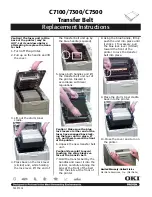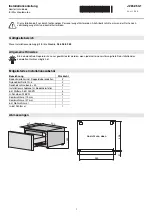
MOUNTING MICROCELL™ SETS
CAUTION
Do not install Microcells™ in the rain. Do not
trap moisture under the environmental cover of
the Microcell™.
1. Mark two small pieces of masking tape “A.”
Place one piece of tape on the plastic body
of a Microcell™ and one piece near the end
of the Microcell™ cable. Repeat for the other
Microcell™, labeling it “B.”
2. Wipe down a 5 in x 2¼ in (127mm x 57mm)
surface, centered on the template
mounting hole, with degreaser. This cleans the
bare metal and adjacent mounting surface for
the environmental cover.
3. Apply a thin coat of Kistler-Morse
®
rust
inhibitor to the bare metal surface for
Microcell™ A.
Note
Do not apply rust inhibitor beyond this area
or the environmental cover will not adhere
properly.
4. Connect the Microcell™ red, black, and white
wires to the corresponding terminals on the
Kistler-Morse
®
Test Meter. Turn on the power
to the meter and set the Simulate/Test Switch
to the Test position.
Note
If a Kistler-Morse
®
Test Meter is not available,
refer to Appendix C (Alternate Method for
Checking Output) before proceeding with
Step 5.
5. With the cable end down, align
Microcell™ A with the mounting holes,
ensuring that the top of Microcell™ A faces
toward the vessel load point. Fasten the
Microcell™ loosely to the web using the two
#8-32 x
5
/
8
” socket head cap screws and
washers. Do not tighten the screws. If the
voltage goes outside the range of -100mV to
+100mV, immediately loosen the screw(s).
CAUTION
For proper installation, tighten each screw until
the T-handle driver flexes in torsion ¼ turn past
the point where the screw stops turning.
Repeat this flexing procedure several times to
ensure the screw is tight. When both screws
are tight, the voltages must be in the range of
-100mV to +100mV. Follow the procedure in
Steps 6 through 8 to achieve this goal.
6. Using the T-handle driver, slowly tighten the
top screw. While turning the T-handle driver,
monitor the test meter carefully. If the
voltage goes outside the range of -100mV to
+100mV while tightening, stop immediately
and evaluate the following:
A. If the voltage jumped outside the range of
-100mV to +100mV, it may indicate a burr
or rough surface. Remove the screws
holding the Microcell™ to the web. Check
for and remove burrs and surface
roughness (refer to SURFACE
PREPARATION for removing surface
roughness). Repeat Steps 1 through 6.
B. If the voltage gradually moved outside the
range of -100mV to +100mV, slowly loosen
the screw until the voltage is within the
range again and proceed to Step 7.
7. Repeat Step 6 for the bottom screw. If the
voltage is outside the range of -100mV to
+100mV, attempt to bring the reading within
range by loosening the screw being torqued,
tightening the other screw, or some
combination of loosening and tightening. If
you have difficulty staying within the range,
try turning each screw ¼ turn at a time until
both screws are tightened.
Note
If the following occurs while tightening screws,
check Microcell™ resistance using a DMM
(described in Problem 1 in Chapter 6):
A. Voltage does not change or changes less
than 25mV as you turn a screw,
or
B. Voltage changes randomly as you turn a
screw (i.e., not in a consistent direction).
21
Содержание Microcell
Страница 20: ...Figure 3 18 Cutting Wrap Width Figure 3 19 Installing Brace Wrap 16 ...
Страница 22: ...Figure 4 2 Microcell Mounting Locations 18 ...
Страница 30: ...Figure 4 16 Wiring Junction Boxes Together Non Conduited Installation 26 ...
Страница 37: ...33 ...
Страница 42: ...38 ...
Страница 43: ......
















































